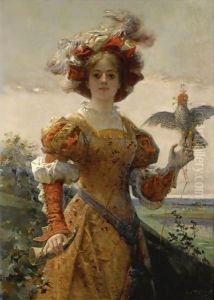Edmond-Louis Dupain Paintings
Edmond-Louis Dupain, born in 1847 and passing away in 1933, was a French artist whose work spanned several decades, reflecting the artistic transitions from the late 19th century into the early 20th century. Although not as widely recognized as some of his contemporaries, Dupain's contributions to the art world, particularly in painting and sculpture, showcase a unique blend of traditional and emerging styles of his time.
Dupain's early life was steeped in the artistic traditions of France, and he showed a remarkable aptitude for the arts from a young age. He pursued his artistic education at the École des Beaux-Arts in Paris, where he was influenced by the academic art teachings of the period but was also exposed to the burgeoning movements that would later define the modernist era. His works, initially deeply rooted in the academic style, gradually began to incorporate elements of impressionism and post-impressionism, reflecting the evolving artistic landscape of France.
Throughout his career, Dupain exhibited his works in various salons and galleries, gaining modest recognition among art enthusiasts and critics. His paintings often depicted scenes of French rural life, landscapes, and portraits, characterized by a delicate use of light and color. Dupain was particularly adept at capturing the transient effects of light on the landscape, a hallmark of impressionist art, yet he maintained a certain structural composition that nodded to his academic roots.
In addition to painting, Dupain also explored sculpture, creating several notable pieces that further emphasized his versatile talent. His sculptures often mirrored the themes of his paintings, focusing on the beauty of the natural world and the human figure, but with a palpable sense of realism and attention to detail.
Despite his contributions to the art world, Edmond-Louis Dupain's work has often been overshadowed by that of his more famous peers. However, recent years have seen a renewed interest in his oeuvre, with art historians and collectors alike appreciating the subtle interplay of traditional and modern elements in his work. Dupain's legacy, though quiet, remains an important testament to the rich artistic ferment of his time, bridging the gap between the classical and the new, the structured and the spontaneous.

